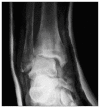Posterior tibial tendon displacement behind the tibia and its interposition in an irreducible isolated ankle dislocation: a case report and literature review
- PMID: 27900312
- PMCID: PMC5115244
- DOI: 10.11138/jts/2016.4.3.183
Posterior tibial tendon displacement behind the tibia and its interposition in an irreducible isolated ankle dislocation: a case report and literature review
Abstract
Isolated posteromedial ankle dislocation is a rare condition thanks to the highly congruent anatomical configuration of the ankle mortise, in which the medial and lateral malleoli greatly reduce the rotational movement of the talus, and the strength of the ligaments higher than the malleoli affords protection against fractures. However, other factors, like medial malleolus hypoplasia, laxity of the ligaments, peroneal muscle weakness and previous ankle sprains, could predispose to pure dislocation. In the absence of such factors, only a complex high-energy trauma, with a rotational component, can lead to this event. Irreducibility of an ankle dislocation, which is rarely encountered, can be due to soft tissue interposition. Dislocation of the posterior tibial tendon can be the cause of an irreducible talar dislocation; interposition of this tendon, found to have slid posteriorly to the distal tibia and then passed through the tibioperoneal syndesmosis, is reported in just a few cases of ankle fracture-dislocation.
Keywords: ankle dislocation; displacement; irreducible; open reduction; posterior tibial tendon.
Figures







Similar articles
-
Equinus foot deformity and malunion of the medial malleolus caused by tibialis posterior tendon interposition following irreducible fracture dislocation of the ankle: A case report and literature review.Trauma Case Rep. 2022 Jan 26;38:100618. doi: 10.1016/j.tcr.2022.100618. eCollection 2022 Apr. Trauma Case Rep. 2022. PMID: 35141390 Free PMC article.
-
Ankle fracture-dislocation with the interposition of the tibialis posterior tendon in the ankle syndesmosis and tibiotalar joint - A case report and systematic literature review.Int J Surg Case Rep. 2023 Sep;110:108710. doi: 10.1016/j.ijscr.2023.108710. Epub 2023 Aug 22. Int J Surg Case Rep. 2023. PMID: 37625231 Free PMC article.
-
Irreducible ankle fracture dislocation due to posterior tibialis tendon interposition: Diagnostic and clues for early management - A case report.Trauma Case Rep. 2019 Mar 2;20:100175. doi: 10.1016/j.tcr.2019.100175. eCollection 2019 Apr. Trauma Case Rep. 2019. PMID: 30906840 Free PMC article.
-
Pure dislocation of the ankle: three case reports and literature review.Clin Orthop Relat Res. 2001 Jan;(382):179-84. Clin Orthop Relat Res. 2001. PMID: 11153985 Review.
-
Anterolateral subluxation of the talus after overlooked dislocation of the tibialis posterior tendon.J Orthop Trauma. 1994 Oct;8(5):449-53. doi: 10.1097/00005131-199410000-00016. J Orthop Trauma. 1994. PMID: 7996333 Review.
Cited by
-
Irreducible Fractures and Dislocations of the Ankle Associated With Entrapment of the Posterior Tibial Tendon Within the Tibiofibular Interosseous Space: A Case Series and Literature Review.Foot Ankle Orthop. 2021 Apr 15;6(2):24730114211000297. doi: 10.1177/24730114211000297. eCollection 2021 Apr. Foot Ankle Orthop. 2021. PMID: 35097438 Free PMC article.
-
Equinus foot deformity and malunion of the medial malleolus caused by tibialis posterior tendon interposition following irreducible fracture dislocation of the ankle: A case report and literature review.Trauma Case Rep. 2022 Jan 26;38:100618. doi: 10.1016/j.tcr.2022.100618. eCollection 2022 Apr. Trauma Case Rep. 2022. PMID: 35141390 Free PMC article.
-
Possible effect of morphological variations of plantaris muscle tendon on harvesting at reconstruction surgery-case report.Surg Radiol Anat. 2020 Oct;42(10):1183-1188. doi: 10.1007/s00276-020-02463-1. Epub 2020 Apr 4. Surg Radiol Anat. 2020. PMID: 32248255 Free PMC article.
-
Knee surgery, arthroscopy, sports traumatology, cartilage repair and technology in orthopaedics: looking for a possible unifying concept for joint care.Joints. 2016 Sep 21;4(3):133. doi: 10.11138/jts/2016.4.3.133. eCollection 2016 Jul-Sep. Joints. 2016. PMID: 27900303 Free PMC article. No abstract available.
-
The Plantaris Muscle Tendon and Its Relationship with the Achilles Tendinopathy.Biomed Res Int. 2018 May 31;2018:9623579. doi: 10.1155/2018/9623579. eCollection 2018. Biomed Res Int. 2018. PMID: 29955614 Free PMC article.
References
-
- Hsiao KC, Tu CH. Irreducible fracture dislocation of the ankle: report of two cases. J Formos Med Assoc. 1994;93( Suppl 3):S161–S165. - PubMed
-
- Schatzker J, Johnson RG. Fracture-dislocation of the ankle with anterior dislocation of the fibula. J Trauma. 1983;23:420–423. - PubMed
-
- Mayer PJ, Evarts CM. Fracture-dislocation of the ankle with posterior entrapment of the fibula behind the tibia. J Bone Joint Surg Am. 1978;60:320–324. - PubMed
-
- Schatzker J, McBroom R, Dzioba R. Irreducible fracture dislocation of the ankle due to posterior dislocation of the fibula. J Trauma. 1977;17:397–401. - PubMed
-
- Coonrad RW, Bugg EI., Jr Trapping of the posterior tibial tendon and interposition of the soft tissue in severe fractures about the ankle joint. J Bone Joint Surg Am. 1954;36-A:744–750. - PubMed
LinkOut - more resources
Full Text Sources
Other Literature Sources
